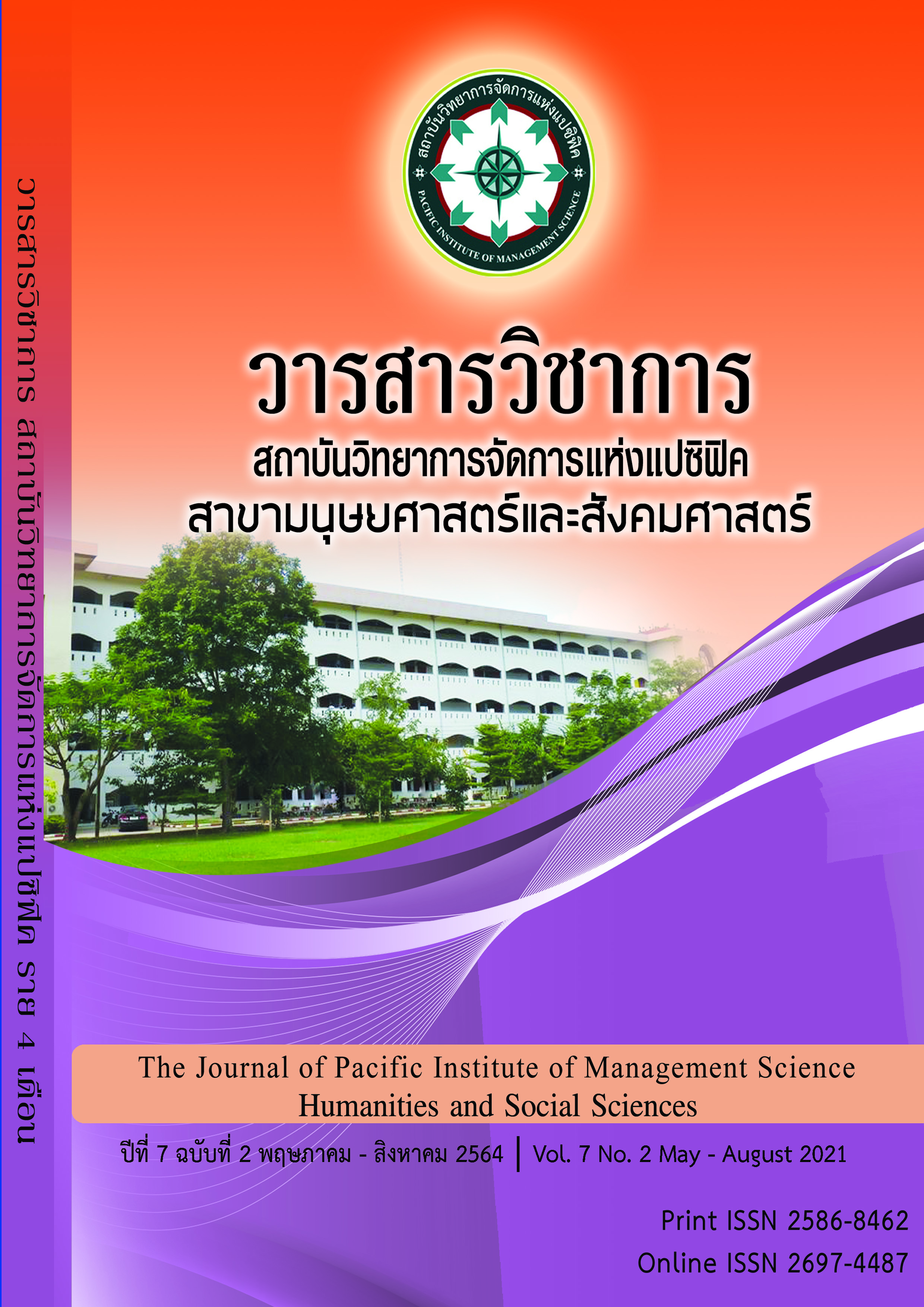The Cloth Mask Behavior in COVID-19 Prevention Of the peoples of Pathumthani Province
Keywords:
Cloth mask for behavior, COVID-19, Health believeAbstract
The research of this descriptive were to study the cloth mask for behavior in COVID-19 prevention of the peoples in Pathumthani Province. The study samples were consisted of 220 peoples by simple random sampling at Bangdue Subdistrict, Mueang District, Pathum Thani Province. Data were collected using the demographic data record form, the cloth mask behavior questionnaire, and the health believe questionnaire. The content validity test were at. 1 and reliability test was conducted using Cronbach’s alpha coefficient which were at .92 and .86 consecutively. The demographic data analysis consisted of frequency, mean, standard deviation, and Pearson’s Product Moment Correlation coefficient.
The results of the study showed that health believe of perceived susceptibility, perceived severity, and cues to action related to cloth mask for behavior were statistically significant difference of .05 (r = .226, .226, and .216 consecutively).
The suggestion should be peoples for promotion the perception of health believe to improving the infection.
References
ขวัญใจ มอนไธสง. (2559). ปัจจัยทำนายพฤติกรรมการป้องกันวัณโรคของผู้สัมผัสร่วมบ้านกับ
ผู้ป่วยวัณโรคปอดที่พักอาศัยในกรุงเทพมหานครและปริมณฑล.วิทยานิพนธ์พยาบาลศาสตร์มหาบัณฑิต สาขาเวชปฏิบัติชุมชน.คณะพยาบาลศาสตร์ มหาวิทยาลัยธรรมศาสตร์.
ขนิษฐา เอกปัชฌาย์ วันชัยมุ้งตุ้ย และจิตตาภรณ์ จิตรีเชื้อ. (2559). ปัจจัยทำนายความตั้งใจ
ปฏิบัติการป้องกัน การติดเชื้อวัณโรคของพยาบาลวิชาชีพในโรงพยาบาลทั่วไป.วารสารสภาการพยาบาล. 42(3). 25 –35.
จารุวรรณ แหลมไธสง. (2562). ปัจจัยที่มีอิทธิพลต่อพฤติกรรมป้องกันโรคติดเชื้อในระบบทางเดิน
หายใจ ของผู้ดูแลเด็กปฐมวัยในศูนย์เด็กเล็ก กรุงเทพมหานคร.วารสารมหาวิทยาลัยบูรพา. 43(3). 223 –235.
มหาวิทยาลัยมหิดล. (2563). ความรู้พื้นฐาน COVID - 19 การติดเชื้ออการป่วย การดูแลรักษา การ
ป้องกันการแพร่เชื้อและการติดเชื้อ. กรุงเทพมหานคร: มหาวิทยาลัยมหิดล.
สุรัยยา หมานมานะ โสภณ เอี่ยมศิริถาวร และสุมนมาลย์ อุทยมกุล. (2563). โรคติดเชื้อไวรัสโคโรนา
(COVID-19). วารสารสถาบันบำราศนราดูร.14(2): 124-33.
Burns N, Grove, SK. (2005). The practice of nursing research: Conduct, critique, &
utilization (5th ed.) Philadelphia: W.B. Saunders.
Fisher D, Heymann D. (2020). Q & A: The novel coronavirus outbreak causing Covid –19. BMC medicine.18(1) :1-3.
MacIntyre CR, Seale H, Dung TC, Hien NT, Nga PT, Chughtai AA, et al. (2015).A cluster randomised trial of cloth masks compared with medical masks in healthcare workers. BMJ open 2015; 5(4): e006577. https://bmjopen.bmj. com/content/5/4/e006577
Rosenstock IM. (1990). Model of individual health behavior. In Glanz K, Lewis FM,
Rimer BK, (editors). Health behavior and health education: theory, research and practice. San Francisco: Jossey-Bass Publishers. 33-62.
Strecher VJ, Rosenstock IM. (1997). The health belief model. In Glanz K, Lewis FM,
Rimer BK, editors. Health behavior and health education: theory, research, and practice. 2nd ed.San Francisco: Jossey-Bass,
Van Doremalen et al. (2020). Aerosol and surface stability of SARS-CoV-2 as
compared with SARS-CoV-19. New England Journal of Medicine, 382(16), 1564-1567.
Downloads
Published
Issue
Section
License
Copyright (c) 2021 Pacific Institute of Management Science

This work is licensed under a Creative Commons Attribution-NonCommercial-NoDerivatives 4.0 International License.
บทความที่ได้รับการตีพิมพ์เป็นลิขสิทธิ์ของ สถาบันวิทยาการจัดการแห่งแปซิฟิค
ข้อความที่ปรากฏในบทความแต่ละเรื่องในวารสารวิชาการเล่มนี้เป็นความคิดเห็นส่วนตัวของผู้เขียนแต่ละท่านไม่เกี่ยวข้องกับสถาบันวิทยาการจัดการแห่งแปซิฟิค และคณาจารย์ท่านอื่นๆในสถาบันฯ แต่อย่างใด ความรับผิดชอบองค์ประกอบทั้งหมดของบทความแต่ละเรื่องเป็นของผู้เขียนแต่ละท่าน หากมีความผิดพลาดใดๆ ผู้เขียนแต่ละท่านจะรับผิดชอบบทความของตนเองแต่ผู้เดียว







